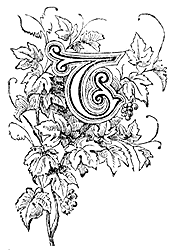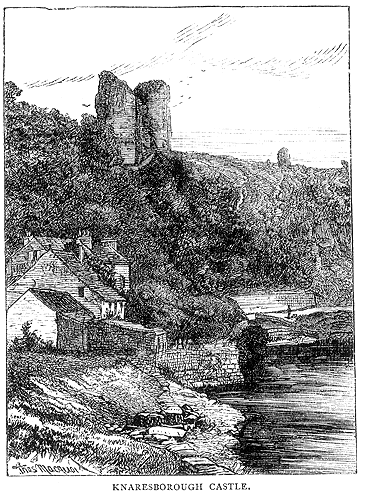 |
 
HE banks of the Nid, near Knaresborough, are beautifully picturesque, and have several spots full of interest situated close to them. The Dropping Well is one of these. It is in the Long Walk, which is entered by a gate to the right after crossing the bridge. It rises from the foot of a limestone rock, about forty yards from the Nid, and on reaching the rock from which it falls - a rock beautifully adorned with flowers and shrubs - it diffuses itself, and trickles down in a number of sparkling rills. Twenty gallons of water flow from the spring every minute, and it is so strongly impregnated with lime that articles left under it are soon hardened with it, or "petrified," as it is called. Tradition says that Mother Shipton, the Yorkshire prophetess, was born at the foot of this rock. This woman is said to have lived in the reign of Henry VIII. There is a well-known story that she prophesied that Wolsey should never get York Minster; that he was shown the magnificent cathedral from the top of a tower, and uttered a vow of vengeance against Mother Shipton for her ill-omened prophecy.
The prophecies of the middle ages were, it is well known, political instruments for
influencing the people, who believed them, and acted so as to ensure their fulfilment. They were always numerous in troubled reigns, in those of Richard II. Henry VI. and Henry VIII. especially, and laws were made against them.
In a rude wooden cut Mother Shipton appears holding in her left hand a staff or wand with the head of a bird on it; a superstitious image probably descending from the ancient Egyptian gom. She is draped in a long loose gown, narrow white neckband, and a strange high cap - a steeple crown and broad brim. Mother Shipton, though always considered to be a witch, escaped the cruel fate of the women who professed the black art, and died in her bed at extreme old age, near Clifton, in Yorkshire. A stone is said to have been erected to her memory in Clifton churchyard, with the following epitaph:
Among those who consulted her was the Abbot of Beverley, to whom she foretold the suppression of the monasteries. She foretold Henry VIII.'s marriage with Anne Boleyn; the burning of heretics at Smithfield. and the execution of Mary Queen of Scots. She also foretold the accession of James I., adding that with him
Winslow-cum-Shipton, in Bucks, also claims to be the birthplace of Mother Shipton.
Going back across the bridge and turning to the right the tourist will come on St. Robert's Chapel. It is not a building, but is hollowed out of the solid rock, and is only ten feet six inches long, nine feet wide, and seven feet six inches high. On one side of the entrance is the figure of a Knight Templar rudely cut in the rock within, the roof and altar are well carved in Gothic fashion, and there are niches now void of the statues of virgin or saint. This chapel was the work of St. Robert of Knaresborough, a very pious man, who was born at York, and devoted himself to a monastic life.

Knaresborough Castle was in former years a noted fortress, occupying an elevated position and defended on the accessible side by a vast fosse with strong works outside it. It now consists only of scattered ruins, though they show that it was of great extent. Lord Lytton has made this place remarkable by his novel of "Eugene Aram," and we think our readers will not object to read his description of the castle. "You would be at a loss," he says, "to recognise now the truth of old Leland's description of that once stout and gallant bulwark of the north when 'he numbered 11 or 12 toures in the walles of the Castel, and one very faire beside in the second area.' In that castle the four knightly murderers of the haughty Becket (the Wolsey of his age) remained for a whole year, defying the weak justice of the times. There, too, the unfortunate Richard II. - the Stuart of the Plantagenets - passed some portion of his bitter imprisonment. And there, also, after the battle of Marston, waved the banner of the Loyalists against the soldiers of Lilburne. It was made yet more touchingly memorable at that time, as you may have heard, by an instance of filial piety. The town was straitened for want of provisions; a youth whose father was in the garrison, was accustomed nightly to get into the deep dry moat, climb up the glacis, and put provisions through a hole where the father stood ready to receive them. He was perceived at length; the soldiers fired on him. He was taken prisoner, and sentenced to be hanged in the sight of the besieged, in order to strike terror into those who might be similarly disposed to render assistance to the garrison. Fortunately, however, the disgrace was spared the memory of Lilburne and the republican arms. With great difficulty a certain lady obtained his respite; and after the conquest of the place and departure of the troops, the adventurous son was released.
"The castle, then, once the residence of Piers Gaveston, of Henry III., and John of Gaunt, was dismantled and destroyed. It is singular, by the way, that it was twice captured by men of the name of Lilburne or Lilleburn, once in the reign of Edward II., once as I have related. On looking over historical records, we are surprised to find how often certain great names have been fatal to certain spots, and this reminds me, by the way, that we boast (at Knaresboro') the origin of the English Sibyl, Mother Shipton. The wild rock at whose feet she is said to have been born is worthy of the tradition."
The actual facts of the story of Eugene Aram scarcely bear out the novel, however; he was not blessed with the many excellences of Lord Lytton's hero. He, John Houseman, and Daniel Clark had defrauded several of the inhabitants of Knaresborough of plate and other goods, to a large amount, and met in St. Robert's Cave to divide their spoil; but Aram and Houseman, wishing to share it only between themselves, murdered the wretched Clark, and buried him in the cave. When Clark's disappearance was noticed, it was thought that he had absconded, and little inquiry was made for him. Eugene Aram went to Norfolk, where he lived for thirteen years, finally as usher in the school in which Admiral Burney was a pupil. Discovery then came. A labourer digging in a quarry found a human skeleton, and the people called to see it asserted that it must be that of Clark, whose strange disappearance had never been explained; but Houseman, who was present (and half drunk), took hold of one of the bones, and said that it was no more Daniel Clark's than it was his. He was thus brought under suspicion, an inquest was held, and Houseman at length confessed his guilt and sent the officers of justice to search for the body in St. Robert's Cave. It was found. Eugene Aram was arrested at Lynn, in Norfolk, where, as we have said, he was an usher.
Houseman turned king's evidence, and Aram was convicted and hanged. His defence of himself was quite wonderful for its eloquence and erudition. He tried to escape the gallows by suicide, and was nearly insensible from the loss of blood when brought to the scaffold.
He was born at Ramsgill, about 18 miles from Knaresborough, in 1700, and was executed in 1759. He was a man of extraordinary ability, knowing Latin, Greek, Hebrew, and many other languages; and was also a good mathematician and antiquarian.
Knaresborough was the birthplace of another very extraordinary man - John Metcalf - called Blind Jack of Knaresborough. He was born in 1717, and lost his sight at four years old. Nevertheless, he adopted the business of common carrier between Knaresborough and York, and often acted as a guide through the intricate roads of the forest during the night - for day and night to him were alike - or through paths hidden by the snow. He was fond of hunting, and would follow the hounds, on foot or on horseback as well as if he had had his sight. He also contracted for, and built roads, bridges and houses, and kept at this business for forty years. He died in 1810, aged 93.
Knaresborough is a picturesque town, with its river, rocks, woods, castle and houses piled up the sides of the cliff, well worth visiting from its offering many subjects to the landscape painter and much interest to the tourist.
|
 |